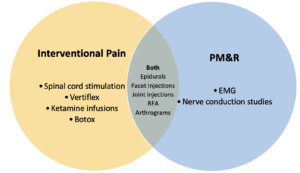Chiropractor? PM&R? Pain Management? Spine Surgeon? Choosing the right specialist.
Neck and back pain can be tricky to diagnose, can take time to treat, and all the while can cause a great deal of discomfort.
Often, it’s difficult to know where to turn for the right care for your pain. There are a range of different professionals who address neck and back pain, including chiropractors, rehabilitation doctors, interventional pain management physicians, and spine surgeons. All of them take a systematic approach to best restore your health, but all approach the problem in a different way.
Knowing what type of provider to see for your symptoms can be confusing, but there are general considerations to follow:
Chiropractor
A chiropractor is trained to care for patients’ neuromusculoskeletal system including bones, nerves, muscles, tendons, and ligaments using a non-surgical approach.
They help manage back and neck pain by performing spinal adjustments to maintain proper alignment. Instead of prescribing medication, chiropractors use these treatments that help the body heal on its own.
Symptoms that might bring you to a chiropractor might be neck or low back pain that has an unexplained cause. Among many other conditions, chiropractic care can also benefit those who get tension headaches and migraines, suffer from arthritis, or have frozen shoulder syndrome.
Consider seeing a chiropractor if you are in generally good health and do not have advanced joint disease.
Physical Medicine and Rehabilitation (PM&R) and Interventional Pain Management Physicians
PM&R and Interventional Pain Management Physicians focus on problems surrounding the brain, spinal cord, nerves, joints, and all supporting structures. They use a holistic treatment approach to focus on restoring a patient’s quality of life by looking at all aspects of the patient’s life.
They utilize a thorough physical examination and imaging modalities such as x-ray, MRI, and CT scan to diagnose the source of your pain.
These physicians will utilize a multidisciplinary approach encompassing a multimodal medication regimen, physical therapy, and minimally invasive interventions, such as injections, to help treat the source of your pain.
Both PM&R and interventional pain management physicians can perform procedures including but not limited to epidural injections, facet joint injections, radiofrequency ablation, and joint injections.
A PM&R physician can additionally diagnose nerve related disorders by performing a special test called electromyography (EMG).
An interventional pain management physician can perform additional minimally invasive procedures to treat chronic pain. Examples include:
- Spinal cord stimulation (treats complex regional pain syndrome/diabetic peripheral neuropathy/nerve related pain or ongoing pain after spine fusion surgery)
- Vertiflex (treats spinal stenosis)
- Botox injections (for chronic migraines)
- Infusion therapies such as ketamine infusions (treats depression, chronic headaches and chronic neuropathic pain/fibromyalgia)
These doctors work closely with physical therapists and chiropractors, often utilizing the skillsets of these providers to help treat patients with illness, injuries, or chronic conditions.
You could benefit from seeing a PM&R or interventional pain management physician if you have worsening joint or bone pain, neck or low back pain, knee pain, arthritis, nerve damage causing numbness/tingling in your hands or legs or have suffered from an injury and cannot find relief.
Spine Surgeon
A spine surgeon is a physician who can help treat patients with chronic pain who have not responded to physical therapy, injections, or various medications.
These physicians focus on addressing structural issues with the neck or low back, such as herniated discs, nerve root compression, scoliosis, spinal stenosis, and more.
They can also operate to fix structural issues if they are causing acute issues, such as sudden weakness, loss of sensation, or loss of bowel or bladder function indicating significant spinal cord compression.
If you have been experiencing pain for a long period of time and you have not had long lasting pain relief from physical therapy, multimodal pain medications, or injections, it may be time to consider this option.
When in doubt, make your primary care physician your first stop. From there, you might be referred to a different specialist to address your pain – and hopefully put a stop to it for good.



